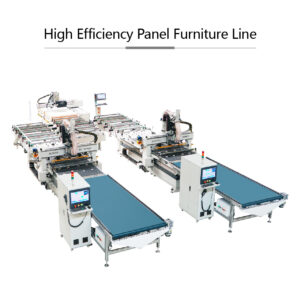Panel furniture manufacturing often involves the use of various materials, each processed differently within the production line:
- Wood-Based Panels:
- Particleboard: Made from wood particles bonded with resin, it’s processed by shaping, pressing, and cutting into required dimensions for different furniture parts.
- Medium-Density Fiberboard (MDF): Composed of wood fibers and resin, MDF is shaped, compressed, and cut to create furniture components due to its smooth surface and uniform density.
- Plywood: Constructed from thin layers of wood veneer glued together, plywood is cut, shaped, and assembled to form furniture parts, providing strength and stability.
- Laminates and Veneers:
- High-Pressure Laminates (HPL): Sheets of HPL are adhered to wood panels through heat and pressure. They provide durability, diverse finishes, and are cut and shaped using specialized equipment.
- Wood Veneers: Thin layers of real wood applied to surfaces for aesthetic purposes. They’re processed similarly to solid wood for cutting, shaping, and assembly.
- Hardware and Accessories:
- Fasteners: Screws, nails, bolts, and other fasteners are used for assembly.
- Hinges and Handles: Processed separately and integrated during assembly stages to facilitate functionality.
- Finishing Materials:
- Paints, Stains, and Coatings: Applied in finishing stages using spraying or coating equipment for protection, aesthetics, and texture.
In the production line, these materials undergo various processes:
- Cutting and Shaping:
- Wood-based panels, laminates, and veneers are cut and shaped using CNC machines, saws, routers, or lasers according to design specifications.
- Edge Banding:
- Edge banding machines apply tapes or strips to panel edges for a finished look and durability.
- Joinery and Assembly:
- Parts are assembled using fasteners, adhesives, or joinery techniques like dadoes, rabbets, or dovetails. Machinery or robotics may aid in precision assembly.
- Finishing and Coating:
- Finishing materials such as paints, stains, or coatings are applied using automated spraying or coating equipment for uniformity and protection.
- Quality Control Checks:
- Throughout the production line, materials and components undergo quality checks for dimensional accuracy, surface quality, assembly integrity, and finishing.
By processing these materials through a well-organized production line, manufacturers create panel furniture with various designs, finishes, and functionalities, meeting quality standards and customer demands.
What safety protocols or measures are in place for workers operating machinery in a panel furniture production line?
Safety protocols and measures for workers operating machinery in a panel furniture production line are crucial to ensure a safe working environment.
Some common safety practices include:
- Training and Education: Comprehensive training programs familiarize workers with machinery operation, safety procedures, and hazard identification. Regular updates on safety protocols are provided.
- Personal Protective Equipment (PPE): Workers are provided with and required to use appropriate PPE such as safety glasses, ear protection, custom panel furniture production line supplier gloves, and safety shoes to minimize risks of injury.
- Machine Guards and Safety Devices: Machinery is equipped with guards, barriers, emergency stops, and other safety devices to prevent accidental contact with moving parts or hazardous areas.
- Regular Maintenance and Inspection: Scheduled maintenance of machinery ensures proper functioning and reduces the risk of unexpected breakdowns or malfunctions that could endanger workers.
- Safety Signage and Labels: Clear and visible signage indicating potential hazards, operating instructions, emergency procedures, and safety guidelines are posted throughout the production area.
- Safe Work Practices: Encouraging safe work practices like maintaining a clean workspace, proper lifting techniques, and reporting any safety concerns or incidents promptly.
- Risk Assessments and Hazard Mitigation: Regular risk assessments are conducted to identify potential hazards, and measures are taken to mitigate risks, enhance safety, and prevent accidents.
- Emergency Preparedness and Response: Workers are trained in emergency procedures such as evacuations, first aid, and fire safety. Adequate fire extinguishers, emergency exits, and evacuation routes are maintained.
- Supervision and Oversight: Supervisors and managers provide oversight to ensure compliance with safety protocols, address safety concerns, and provide guidance to workers.
- Continuous Improvement and Feedback: Encouraging workers to provide feedback on safety concerns or potential improvements fosters a culture of safety and allows for continuous improvement in safety measures.
- Compliance with Regulations: Adherence to local, regional, and national safety regulations and standards applicable to machinery operation and workplace safety.
Implementing and maintaining these safety protocols and measures in a panel furniture production line significantly reduces the risk of workplace accidents, injuries, and ensures the well-being of workers within the manufacturing environment.
